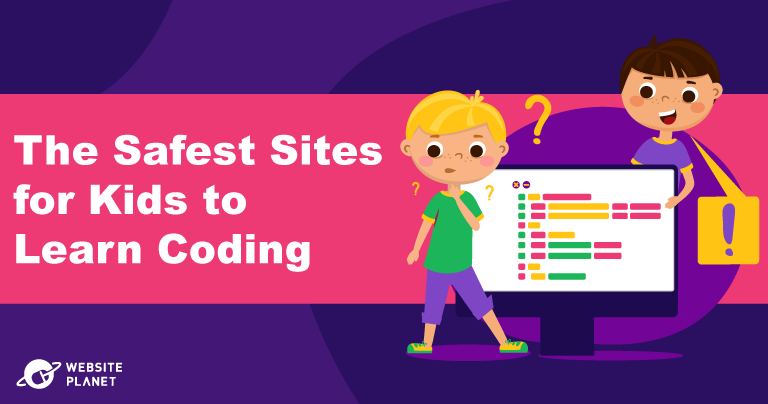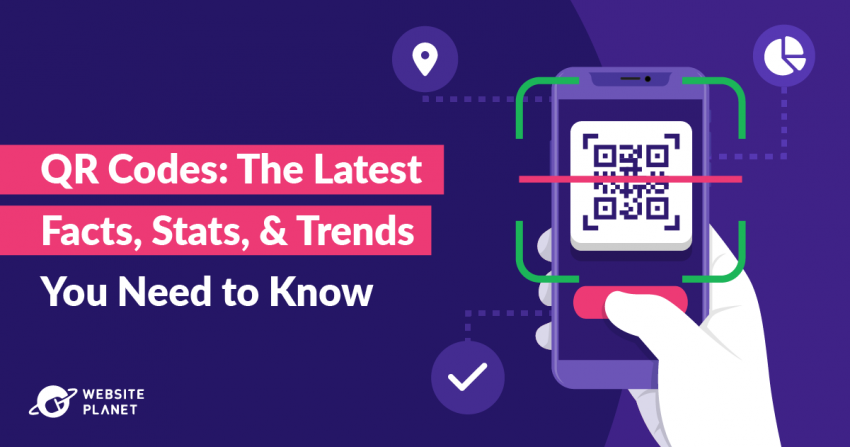Inside this Article
Automation and AI
Automation can save time and reduce errors by handling repetitive tasks. The tools in this section use AI and no-code workflows to streamline everything from email follow-ups to file management.1. ChatGPT
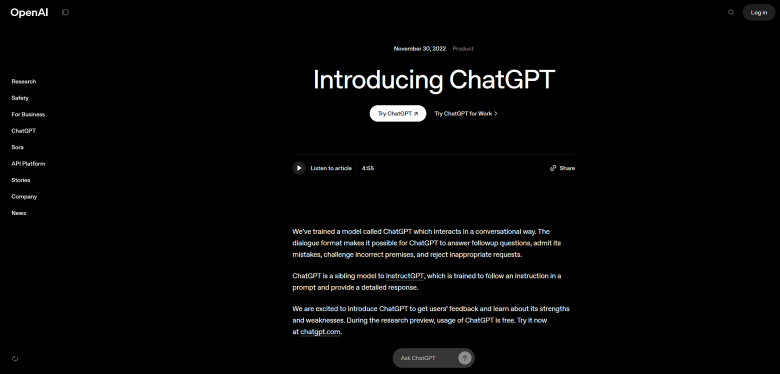 Website: chatgpt.com
Website: chatgpt.comService Type: AI chatbot for writing, coding, research, and productivity
Platforms: Web, iOS, Android, Windows, Mac, Chrome extension
Price: Free (Paid plans start at $20/month) ChatGPT is an AI-powered chatbot that assists users in generating content, answering questions, summarizing text, writing code, translating languages, and more. It’s widely used across industries for tasks like marketing, research, data analysis, and training. The free version includes access to the GPT‑4o model, with limits based on usage and demand. Users can browse the web, upload files, analyze data, chat about images, and try voice conversations. The platform also supports custom GPTs and includes a memory feature that personalizes future replies based on previous interactions. Free users may experience slower speeds and automatic fallback to a less advanced model when limits are reached. Paid plans remove usage caps and unlock additional tools. The Plus plan offers faster, more reliable access to GPT‑4o, while the Pro plan includes features like advanced data analysis and longer context handling for professional users. Key Features:
- Ask questions, write content, summarize text, translate, and code
- Analyze data and create basic charts
- Chat about images and screenshots
- Explore and use custom GPTs
- Personalized responses through memory (optional)
2. Grammarly
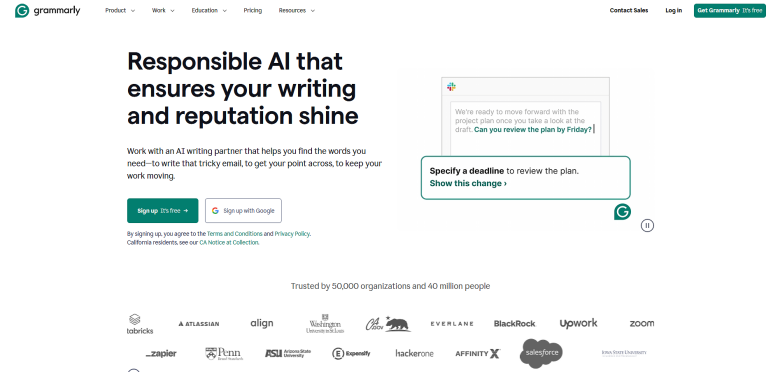 Website: grammarly.com
Website: grammarly.comService Type: AI-powered writing assistant
Platforms: Web, Windows, Mac, iOS, Android, Browser extensions (Chrome, Edge, Safari, Firefox), Add-on for MS Office
Price: Free (Paid plans start at $12/month) Grammarly is a writing assistant that helps users improve spelling, grammar, tone, and clarity in real time. The free version includes grammar and punctuation checks, tone detection, conciseness suggestions, basic citation help, and access to 100 AI prompts per month. Grammarly’s free tier covers most basic writing needs across platforms, but paid plans provide deeper feedback and productivity tools. These include full-sentence rewrites, advanced tone suggestions, vocabulary enhancements, inclusive language tips, and fluency improvements. Paid users also get access to a plagiarism checker, customizable citation styles, up to 2,000 monthly AI prompts, and priority support. Key Features:
- Grammar, spelling, and punctuation correction
- Tone detection for matching audience and intent
- Conciseness suggestions to reduce wordiness
- 100 AI prompts/month for rewriting and ideas
- Sentence rewrites, fluency, and plagiarism checks (for paid users)
3. Zapier
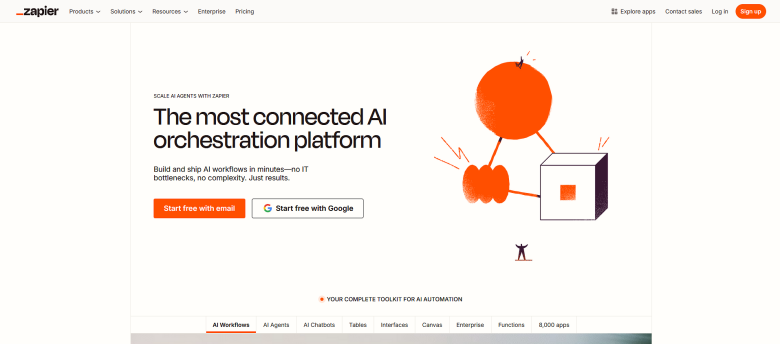 Website: zapier.com
Website: zapier.comService Type: No-code task automation
Platforms: Web, integrations
Price: Free (Paid plans start at $19.99/month) Zapier is a no-code automation platform that lets users connect over 3,000 apps, including Gmail, Trello, Slack, and Google Sheets, to automate repetitive tasks. These automations, called Zaps, can be set up without technical skills and are used to streamline tasks like sending notifications, syncing data, or moving files between tools. The free plan supports unlimited Zaps with up to 100 tasks per month but limits each Zap to just two steps (one trigger and one action). It includes basic features like 15-minute update intervals, AI-powered troubleshooting, drafts, and access to Zapier’s community. However, it doesn’t support webhooks, multi-step workflows, or collaboration. There’s also no access to email or live support. Zapier’s paid plans unlock multi-step Zaps, advanced logic, premium app integrations, and team features. Key Features:
- Build unlimited Zaps with up to 100 tasks per month
- 15-minute update intervals for polling triggers
- AI-powered troubleshooting and Copilot assistance
- Access to Zapier’s free tools: Chatbots, Tables, and Interfaces
Communication and Video Conferencing
When working remotely or meeting with clients, clear communication is essential. These platforms support messaging, calls, and virtual meetings, making it easier to stay connected.4. Slack
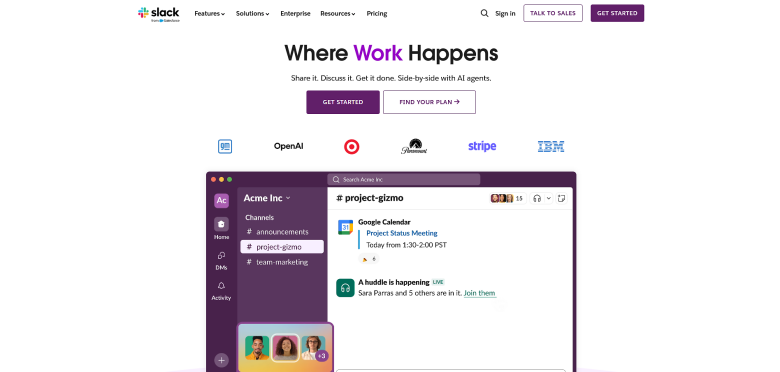 Website: slack.com
Website: slack.comService Type: Messaging and collaboration platform
Platforms: Web, Windows, Mac, Linux, iOS, Android
Price: Free (Paid plans start at $7.25/month per user) Slack is a cloud-based communication platform for teams, offering real-time messaging, file sharing, and integrations with popular tools. It organizes conversations into channels (dedicated spaces for topics, teams, or projects) while also supporting direct messages and small group chats. The free plan includes up to 90 days of message and file history, one-on-one audio and video huddles, and the ability to send short audio or video clips. Teams can create user-defined templates, collaborate in public or private channels, and integrate up to 10 third-party apps, including Google Workspace, Asana, and Trello. Basic security features include data encryption, two-factor authentication, and Google OAuth login. Admins can manage a single workspace with limited channel permissions, primarily for the default #general channel. Free accounts don’t include advanced tools like custom workflows, AI-powered features (e.g., summaries or recaps), enterprise security controls, or access to Slack’s full Workflow Builder. Group huddles, shared canvases, and expanded search are also limited to paid tiers. Key Features:
- Real-time messaging in public and private channels
- 1:1 audio and video huddles, with support for audio/video clips
- Integration with up to 10 third-party tools (e.g., Google Workspace, Trello)
- AI-generated thread summaries and workflow automation (for paid users)
5. Zoom
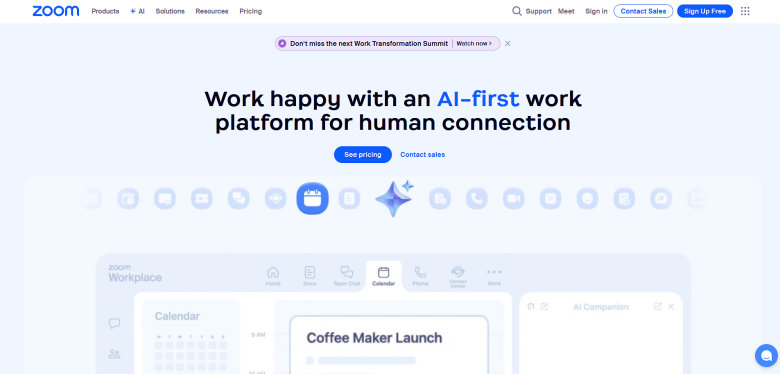 Website: zoom.us
Website: zoom.usService Type: Video conferencing and collaboration
Platforms: Windows, Mac, Linux, iOS, Android, browser extensions (Chrome, Edge, Firefox), Microsoft Outlook plugin
Price: Free (Paid plans start at $13.33/month per user) Zoom is a cloud-based video conferencing platform used for virtual meetings, webinars, and team communication. Users can connect by video, audio, or chat, share screens, and collaborate in real time. Zoom works across desktop and mobile devices, with browser extensions and calendar plugins available for easier scheduling. The free plan allows meetings with up to 100 participants, limited to 40 minutes per session. Users can also access team chat, create up to five short video clips, use a built-in mail and calendar client, and collaborate on up to three editable whiteboards. Basic file sharing, note-taking, and manual task tracking are also included. The free version is suitable for individuals and small teams looking for core video meeting features without cost. However, it does not include AI-based tools, cloud recording, advanced scheduling, or workflow automation. Cloud storage and admin controls like SSO or managed domains are only available on paid plans. Key Features:
- Host meetings with up to 100 participants for 40 minutes per session
- Access to Zoom Team Chat for messaging and file sharing
- Create up to five short video clips (maximum two minutes each)
- Share up to 10 documents and use up to three editable whiteboards
Customer Relationship Management (CRM)
Strong customer relationships drive repeat business. These CRM tools help you track interactions, manage leads, and organize contact data, giving you a clearer view of your sales and support pipelines.6. Brevo
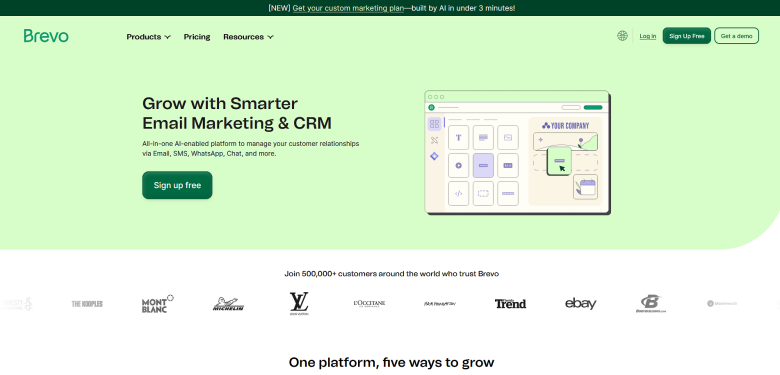 Website: brevo.com
Website: brevo.comService Type: Marketing and CRM platform
Platforms: Web
Price: Free (Paid plans start at $8.08/month) Brevo is a marketing and CRM tool that lets users send emails and SMS messages, live chat, manage contacts, set up basic automation, and track interactions. It also includes a shared inbox for customer conversations and a simple sales pipeline for tracking deals. The free plan supports up to 300 emails per day and allows storage of up to 100,000 contacts. Users can create email campaigns using a drag-and-drop editor, set up basic automation for up to 2,000 active contacts, and access limited analytics. The plan includes one shared inbox for conversations and one sales pipeline with up to 50 open deals. Free accounts are limited to a single user for the Marketing and Conversations tools. Brevo branding appears on all outgoing emails, and campaign scheduling is restricted by the daily send limit. Features like landing pages, A/B testing, Facebook/Instagram chat, and advanced reporting are only available on paid plans. Key Features:
- Send up to 300 emails per day
- Store up to 100,000 contacts
- Drag-and-drop email editor with basic templates
- One shared inbox and one sales pipeline with up to 50 open deals
7. HubSpot CRM
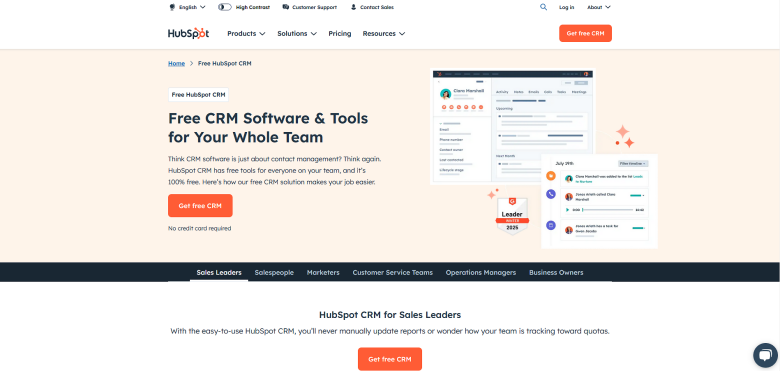 Website: hubspot.com
Website: hubspot.comService Type: CRM and inbound marketing platform
Platforms: Web
Price: Free (Paid plans start at $15/month) HubSpot CRM is a cloud-based platform that helps businesses manage customer relationships across marketing, sales, and support. The free version provides essential tools to organize contacts, track interactions, and automate basic marketing tasks, all within a centralized dashboard. The free plan includes contact and deal management, website activity tracking, customizable email templates, a basic ticketing system, and access to landing pages and form builders. Users can manage up to 1,000 contacts with no time limit or credit card required. There are some limitations to the free version. Users get only one shared inbox, one email automation workflow, and limited customization options. Advanced features like custom reporting, higher-level automation, A/B testing, and priority support are available through paid plans in HubSpot’s Marketing, Sales, and Service Hubs. Key Features:
- Manage up to 1,000 contacts with built-in contact and deal tracking
- One shared inbox and basic email automation (1 workflow)
- Drag-and-drop builders for landing pages and forms
- Customizable email templates and a basic ticketing system
- Website activity tracking and lead interaction history
8. Zoho CRM
 Website: zoho.com
Website: zoho.comService Type: CRM for sales, marketing, and customer support
Platforms: Web, browser extensions, Windows, Mac, Linux, iOS, Android
Price: Free (Paid plans start at $20/month) Zoho CRM is a cloud-based tool for managing customer relationships across sales, marketing, and support. The platform supports multichannel communication and integrates with Zoho’s broader app ecosystem, as well as third-party tools like Slack, Shopify, and Google Workspace. The free plan is designed for small teams of up to three users. It includes core features such as contact, lead, deal, and account management. Users can track site visitors with Zoho SalesIQ, capture leads through web forms, and automate up to five workflows. Basic email marketing tools are included, along with simple dashboards and reporting. Storage is limited to 5,000 records and 1GB of space. Paid plans remove many of the free plan’s limitations. These include access to advanced automation, AI tools (like Zia), workflow rules, multiple pipelines, social media CRM, scoring rules, calendar booking, and sales forecasting. Key Features:
- Contact, lead, deal, and account management for up to 3 users
- Web form lead capture and visitor tracking with Zoho SalesIQ
- Up to 5 workflow automation rules
- Basic email marketing tools with templates and formatting
- Customizable dashboards and standard reports for performance tracking
Design and Creative Tools
Visual branding plays a major role in how customers perceive your business. These free design tools make it easier to create logos, graphics, and other creative assets without the need for professional design experience.9. Canva
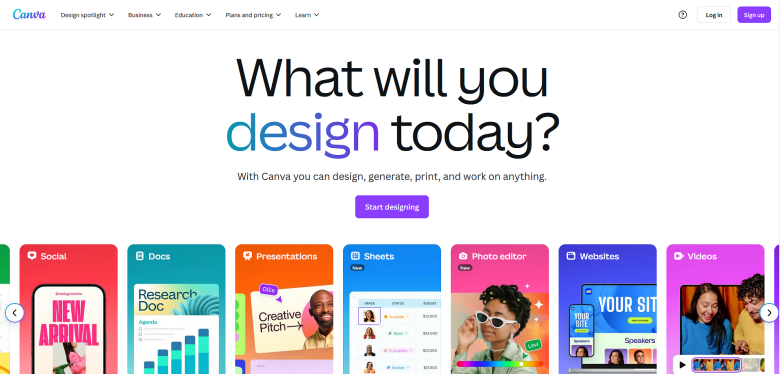 Website: canva.com
Website: canva.comService Type: Graphic design tool
Platforms: Web, Windows, Mac, iOS, Android
Price: Free (Paid plans start at $15/month) Canva is a free, user-friendly graphic design platform used by over 30 million people worldwide. It offers a drag-and-drop editor and thousands of customizable templates for creating social media posts, presentations, flyers, business cards, and other visual content. The free version includes 250,000+ templates, access to over 1 million stock photos and graphics, basic AI design tools, and 5GB of cloud storage. Users can upload their own files, collaborate with others, and access print services directly through the platform. Canva also provides a free QR code generator and supports standard export formats including JPG, PNG, and PDF. For those with more complex needs, Canva Pro includes features like brand kits, premium content, and AI tools such as Magic Write. The free version covers most core functions that individual users and small teams typically need. Limitations include no transparent background exports, SVG file support, or advanced team controls. Key Features:
- Access to 250,000+ free templates and 1+ million stock photos, videos, and graphics
- Drag-and-drop editor with support for images, PDFs, and presentations
- 5 GB of free cloud storage for saving and organizing projects
- AI tools like Magic Write (for paid users)
10. Penpot
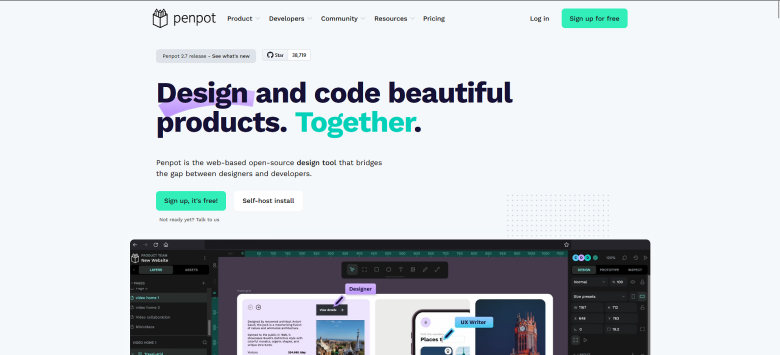 Website: penpot.app
Website: penpot.appService Type: UX design and collaboration tool
Platforms: Web
Price: Free (Paid plans start at $7/month) Penpot is a browser-based, open-source design tool built for collaboration between designers and developers. It supports interface design, prototyping, and real-time teamwork, with features like reusable components, design systems, transitions, and shareable presentations. The free plan includes unlimited design files and projects, a drag-and-drop editor, support for plugins, and collaboration with up to eight editors per team. Users get 10GB of cloud storage and a 7-day version history. Penpot also provides code inspection tools, measurement guides, and a read-only mode for developers. Users can start with built-in templates or connect multiple projects to manage larger workflows. Design files can be adjusted with full control over layers, positioning, and asset management. For teams with privacy or infrastructure needs, Penpot supports local hosting through Docker or Elestio. This allows users to retain full control over data and user access. Paid plans offer expanded team management and support, starting at $7 per month. Enterprise pricing is also available. Key Features:
- Unlimited design files, projects, and team collaboration (up to 8 editors per team)
- Browser-based drag-and-drop editor with reusable components and prototyping tools
- 10 GB of cloud storage with a 7-day autosave version history
- Built-in developer tools, including code inspection and read-only mode
11. Renderforest
 Website: renderforest.com
Website: renderforest.comService Type: Video creation and animation
Platforms: Web, iOS, Android
Price: Free (Paid plans start at $14/month) Renderforest is a browser-based video and design platform used to create animations, explainer videos, intros, slideshows, and other branded content. It offers over 1,000 templates for video, graphic design, mockups, and websites. The free plan includes videos up to three minutes long (720p with watermark), basic text-to-speech, AI image generation, low-resolution logo creation, and a hosted AI-generated website. Users also get 500MB of cloud storage and access to unlimited graphic design projects. Templates cover a wide range of uses, including product promos, app previews, music visualizations, kinetic typography, and presentations. Renderforest also supports design needs like social media posts, business documents, and invitations. Limitations of the free plan include visible watermarks, limited export quality, no commercial use rights, and restricted access to stock media and editing tools. Upgrading to a paid plan unlocks features such as Full HD exports, commercial rights, branding tools, and extra storage. Key Features:
- Access 1,000+ customizable templates for video, graphics, and mockups
- 500MB cloud storage and a free hosted AI website
- Full HD exports and commercial rights (for paid users)
12. Unsplash
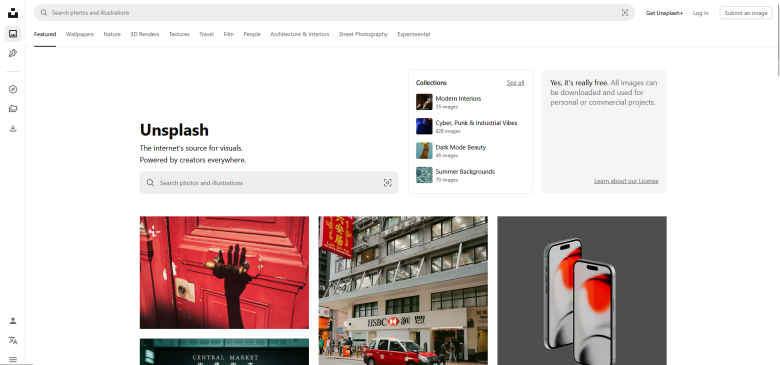 Website: unsplash.com
Website: unsplash.comService Type: Stock images and illustrations
Platforms: Web, iOS
Price: Free (Unsplash+ starts at $12/month) Unsplash is a free stock image platform offering access to over 6 million high-resolution photos and illustrations. All images fall under the Unsplash license, which allows use without payment or attribution, though crediting photographers is encouraged. The platform is regularly updated by a global community of over 200,000 contributors. Users can search by keyword or browse curated collections via the Explore page. Each image includes metadata and photographer information, with options to download, save, or organize content for later use. There’s no sign-up required to access or download content. The license does have some limitations, though — images can’t be sold without meaningful edits, and they can’t be used to build a competing image service. A paid plan, Unsplash+, offers access to additional content and tools for professional users. Key Features:
- Access to 6+ million high-resolution photos and illustrations under the Unsplash License
- Free for commercial and non-commercial use with no attribution required
- No account or sign-up needed to browse, download, or save images
Finance and Accounting
Having a clear view of your finances helps you stay in control. These tools help small teams and solo entrepreneurs manage invoicing, track expenses, and organize their books, often for free or at a low cost.13. Wave Accounting
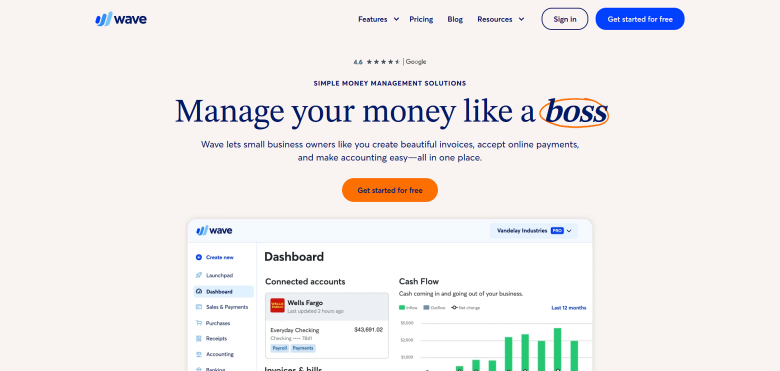 Website: waveapps.com
Website: waveapps.comService Type: Cloud-based accounting software
Platforms: Web, iOS, Android
Price: Free (Pro plan $170/year) Wave is a free accounting platform designed for small businesses, freelancers, and sole proprietors. It includes core tools for invoicing, accounting, and receipt scanning, with no limits on usage or number of users. Users can create unlimited invoices, connect multiple bank accounts, and manage more than one business from a single login. The free plan includes annual receipt uploads, essential reports, unlimited bank and card connections, and email support. However, features like automatic bank imports, automated reminders, and recurring billing are reserved for Pro users. The Pro Plan also adds unlimited receipt scanning and live chat support. The platform is fully functional without payment, but fees apply when accepting online payments. On the free plan, credit card payments incur a 2.9% + ¢60 per transaction fee. The Pro Plan waives the ¢60 fee but keeps the 2.9% rate. Key Features:
- Unlimited invoices with automatic follow-ups
- Connect unlimited bank and credit card accounts
- Multiple businesses under one account
- Manual receipt scanning via the mobile app
14. Zoho Books
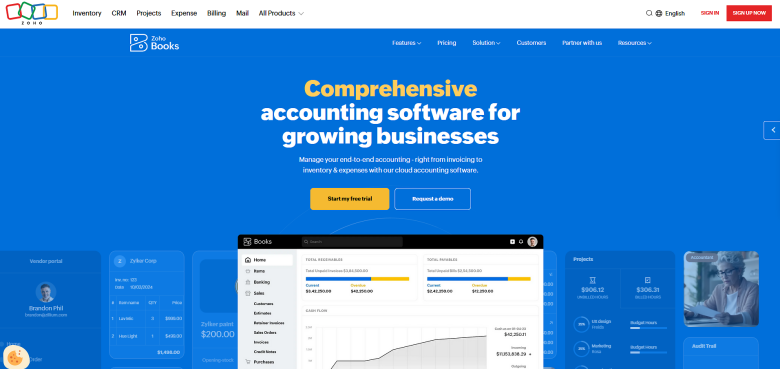 Website: zoho.com
Website: zoho.comService Type: Accounting software for small businesses
Platforms: Web-based, Windows, iOS, Android
Price: Free (Paid plans start at $20/month) Zoho Books is cloud-based accounting software built for small businesses, freelancers, and self-employed professionals. It helps users handle invoices, track expenses, reconcile accounts, and generate reports. The free plan includes core tools for managing day-to-day finances with no monthly fee. Users can send up to 1,000 invoices per year, track 1,000 expenses, connect bank and credit card accounts (manual imports only), and accept payments via PayPal or Stripe. The customer portal allows clients to view invoices, make payments, and leave feedback. Users can also access over 50 built-in reports for tracking financial performance and can grant access to one accountant. The free plan is mobile-friendly and includes email-based support. However, it lacks automation, customization, and scalability. Features such as recurring billing, inventory tracking, budgeting, and bank feeds are only available in paid plans. Key Features:
- Create and send up to 1,000 invoices per year
- Track up to 1,000 expenses annually
- Manually import and reconcile bank and credit card transactions
- Accept online payments via PayPal or Stripe
- Access over 50 built-in financial reports
Marketing and Social Media
Reaching the right audience is essential for growth. The platforms in this section help you schedule content, run campaigns, and track performance, so you can promote your business more effectively, even on a tight budget.15. Google Analytics
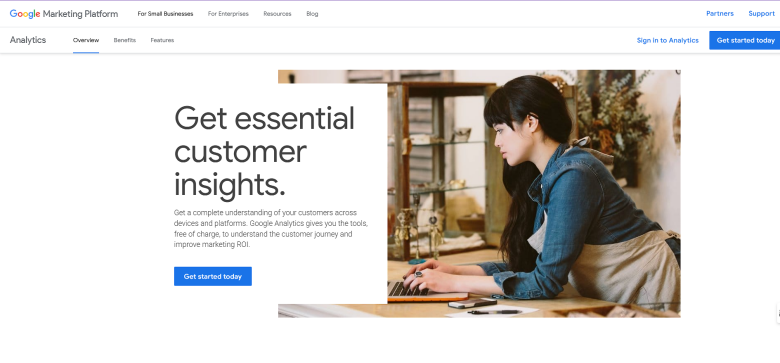 Website: marketingplatform.google.com
Website: marketingplatform.google.comService Type: Website and app traffic tracking
Platforms: Web app, iOS, Android
Price: Free (Paid plans start at $50,000/year) Google Analytics is a web analytics service that helps businesses track and understand how users interact with their websites and apps. It provides real-time data on visitor behavior, traffic sources, and marketing performance. The free version (GA4) is suitable for small and medium businesses, offering insights like user demographics, device usage, and engagement metrics. It also supports cross-platform tracking, customizable dashboards, automatic event tracking, and integration with other Google tools like Google Ads, Search Console, and Firebase. The premium version, Google Analytics 360, is designed for larger organizations. It offers advanced features such as unsampled data, longer data retention, enterprise-level integrations, and a service-level agreement (SLA) for support and uptime. Key Features:
- Tracks website and app traffic across platforms and devices
- Provides real-time data on user behavior, sources, and engagement
- Includes customizable dashboards and visual reports
- Integrates with Google Ads, Search Console, and Firebase
16. Google Tag Manager
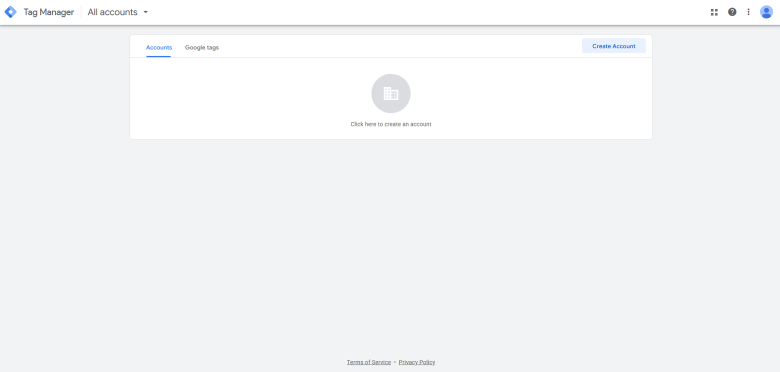 Website: tagmanager.google.com
Website: tagmanager.google.comService Type: Tag management system
Platforms: Web
Price: Free Google Tag Manager (GTM) is a free tool for managing and deploying marketing tags (small pieces of code) on your website or app without editing the underlying source code. It reduces reliance on developers by letting marketers add, update, or remove tags from a central dashboard. GTM integrates with tools like Google Analytics, Google Ads, Facebook, Hotjar, and various CRM platforms. You can track a wide range of user actions, including link clicks, form submissions, file downloads, and video views. Custom event tracking is also supported. The platform includes features for testing, version control, and user permissions. It supports multiple workspaces so teams can work on updates in parallel. Popular tags can be added using built-in templates or community-submitted configurations. While some technical setup is required, GTM can significantly streamline tag management and reduce errors caused by manual code updates. Key Features:
- Central dashboard for managing marketing tags without modifying code
- Integrates with tools like Google Analytics, Google Ads, Facebook Pixel, and Hotjar
- Built-in templates for popular tags and a community template gallery
- Multi-user permission settings and workspace collaboration
- Built-in preview, debug, and testing tools to reduce deployment errors
17. MailerLite
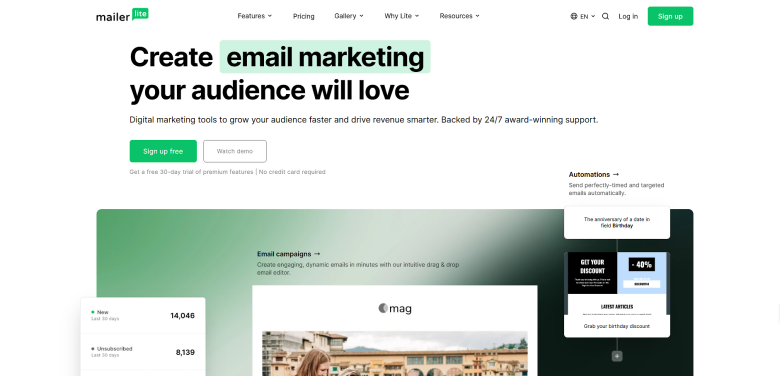 Website: mailerlite.com
Website: mailerlite.comService Type: Email marketing and automation
Platforms: Web, iOS, integrations with major CMS and e-commerce platforms
Price: Free (Paid plans start at $10/month) MailerLite is an email marketing platform that offers tools for building email campaigns, creating signup forms, launching landing pages, and managing subscriber lists. The platform focuses on simplicity and core functionality, making it a good choice for users with modest email marketing needs. The free plan supports up to 1,000 subscribers and 12,000 emails per month. Users can build one website, create up to 10 landing pages, and access basic automation and reporting tools. It also includes a drag-and-drop editor, pop-up forms, segmentation tools, and 24/7 support for the first 30 days. However, MailerLite branding is applied to all emails and pages on the free tier. Paid plans unlock unlimited monthly emails, more user seats, advanced automation workflows, A/B testing, access to 90+ email templates, AI writing assistance, and ongoing support. Users can also remove branding and connect custom domains. Key Features:
- Send up to 12,000 emails per month to 1,000 subscribers
- Drag-and-drop email editor for building campaigns
- One website and up to 10 landing pages
- Basic email automation and reporting tools
- Integrations with popular CMS and e-commerce platforms
18. Metricool
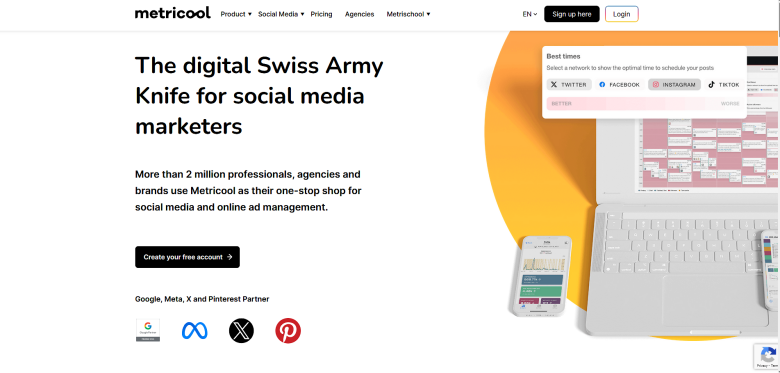 Website: metricool.com
Website: metricool.comService Type: Social media and ad management
Platforms: Chrome extension, iOS, Android
Price: Free (Paid plans start at $18/month) Metricool is designed to help manage social media accounts and online ad campaigns from a single dashboard. It allows users to schedule posts, track performance metrics, monitor competitors, and manage advertising content across multiple platforms. The free plan provides access to core features with some restrictions. Users can manage one brand, schedule up to 50 posts per month (excluding LinkedIn and X), analyze up to five competitor profiles, and access three months of historical analytics. It also has an AI assistant for content generation but lacks downloadable reports, team collaboration tools, or third-party integrations. Paid plans also unlock additional scheduling capacity, SmartLinks, branding features, and deeper analytics. Key Features:
- Schedule up to 50 posts per month across supported platforms
- Analyze up to 5 competitor profiles
- View up to 3 months of historical analytics
- Access basic ad campaign tracking and performance metrics
- Use the built-in AI assistant for generating social media content ideas and captions
19. Yet Another Mail Merge
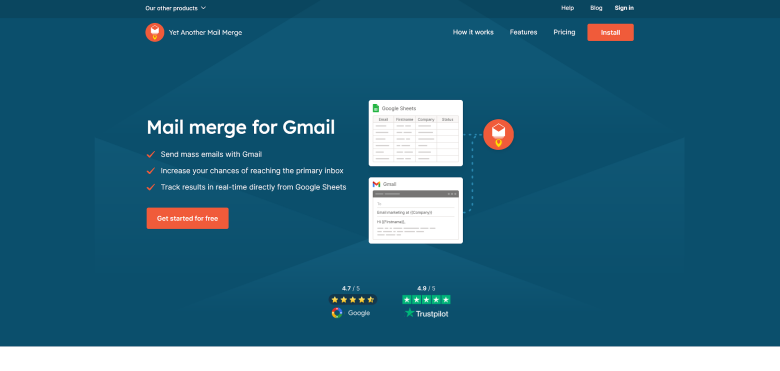 Website: yamm.com
Website: yamm.comService Type: Gmail-based mail merge and email tracking
Platform: Google Sheets add-on
Price: Free (Paid plans start at $3/month) Yet Another Mail Merge (YAMM) is a Google Sheets add-on that lets users send personalized emails in bulk using their Gmail or Google Workspace account. It connects directly to a spreadsheet, where users can create, send, and track mass email campaigns without needing a separate email marketing platform. The free plan allows up to 20 emails per day, includes open and click tracking and bounce and unsubscribe tracking, and also supports email scheduling. It also removes the YAMM-branded footer and includes basic support for one user. It does not support higher sending limits, advanced automation, or team features. Paid plans unlock daily email limits ranging from 400 to 1,500, as well as multi-user access and premium support. Key Features:
- Send personalized emails to up to 20 recipients per day
- Track opens, clicks, bounces, and unsubscribes in real time
- Schedule email delivery directly from Google Sheets
Project Management and Productivity
Staying organized is key when you’re running a business with limited time or staff. The tools in this section can help you manage tasks, track progress, and collaborate more efficiently.20. Asana
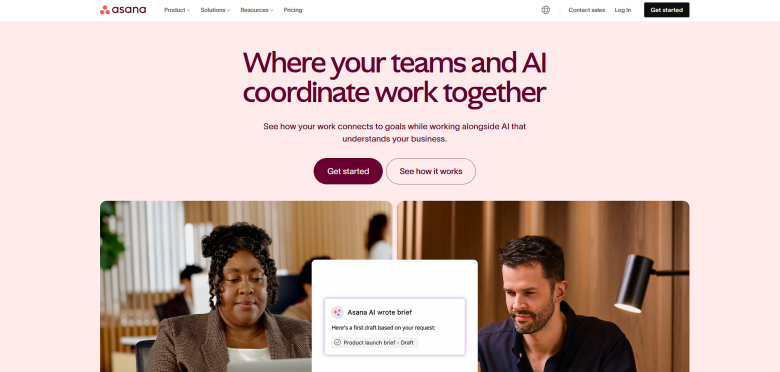 Website: asana.com
Website: asana.comService Type: Project and team management
Platforms: Web, Windows, Mac, iOS, Android
Price: Free (Paid plans start at $9.99/month) Asana is a project management platform designed to help teams organize tasks, track progress, and coordinate work across projects. Users can view tasks in list, board, or calendar formats, assign due dates, and add collaborators. The platform supports integrations with over 100 tools, including time-tracking apps. The free Personal plan includes unlimited tasks, projects, and messages, with file uploads of up to 100MB and support for up to 10 collaborators. Users can assign tasks, add comments, and update project statuses. Teams can also create recurring tasks, manage task dependencies, and use basic search filters. The free plan does not include timeline (Gantt) views, dashboards, automation, custom fields, or advanced reporting tools. Admin controls, guest access, and workflow builders are also limited to paid plans. Key Features:
- Unlimited tasks, projects, and messages for up to 10 teammates
- Task management with assignees, due dates, and comments
- 100MB file upload limit per file with unlimited storage
- Integration with 100+ tools, including time-tracking apps
21. Calendly
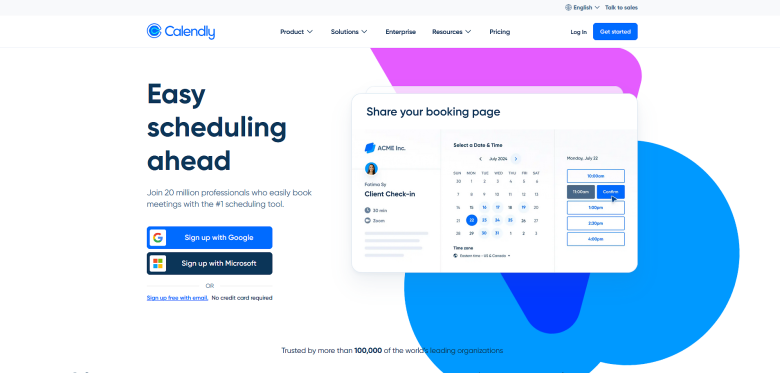 Website: calendly.com
Website: calendly.comService Type: Online scheduling tool
Platforms: Web, iOS, Android, browser extensions (Chrome, Edge, Firefox), email extension (Outlook)
Price: Free (Paid plans start at $10/month per user) Calendly is an online scheduling tool that helps individuals and teams automate the booking of meetings. Users connect their calendar, define their availability, and share a personalized booking link. Invitees see open time slots in their own time zone and choose a meeting time, avoiding back-and-forth emails and double bookings. The free plan includes one active Event Type, unlimited meetings, and the ability to connect one calendar. Users can set custom hours, add time buffers, sync meetings to their calendar automatically, and integrate with video tools like Zoom, Google Meet, and Microsoft Teams. Free accounts are limited to personal use. There’s no support for team features like round-robin scheduling, pooled availability, or booking on behalf of others. Additional limitations include no automated reminders, follow-up emails, analytics, or form-based invitee screening. Calendly branding remains visible. Key Features:
- Personalized booking page with automatic time zone detection
- Custom availability settings, including working hours and time buffers
- Integration with video tools like Zoom, Google Meet, and Microsoft Teams
22. Clockify
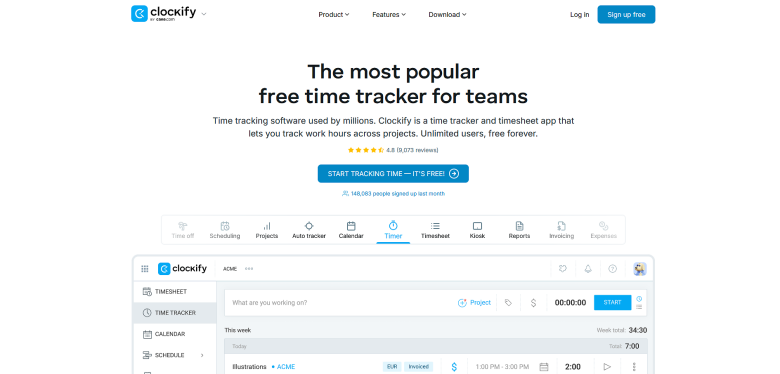 Website: clockify.me
Website: clockify.meService Type: Time tracking and productivity management
Platforms: Web, Windows, Mac, Linux, iOS, Android, browser extensions (Chrome, Edge, Firefox)
Price: Free (Paid plans start at $3.99/month per user) Clockify is a time tracking tool for individuals and teams to log hours, monitor productivity, and track project progress. Users can start a timer, enter time manually, or use automated tools to record work across multiple devices and platforms. The free plan includes unlimited users, projects, and time entries. Features include a timer, timesheets, calendar view, auto-tracking, Pomodoro mode, idle detection, and reminders. Users can generate basic reports, apply billable rates, track team activity, and integrate Clockify with over 50 apps. The free version does not include advanced tools such as invoicing, project templates, GPS tracking, screenshot capture, approvals, or expense management. Features like time-off tracking, multi-user management, and detailed labor cost reporting are limited to paid plans. Key Features:
- Unlimited time tracking for users, projects, and entries
- Timer, manual timesheets, calendar view, and Pomodoro mode
- Basic reports with billable rates and export options
- Integrations with 50+ tools like Trello, Asana, and Slack
23. Google Workspace
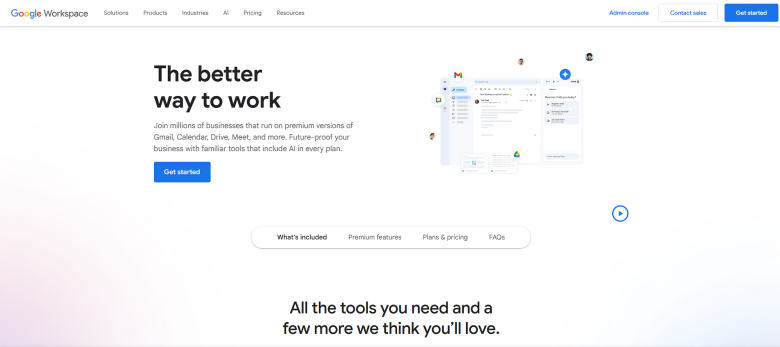 Website: workspace.google.com
Website: workspace.google.comService Type: Cloud-based productivity and collaboration tools
Platforms: Web, iOS, Android (full list of apps and download links)
Price: Free (Paid plans start at $7/month) Google Workspace offers a suite of cloud-based tools, including Gmail, Drive, Docs, Sheets, Slides, Meet, and Calendar. Many of these tools can be accessed for free through Google accounts or via Google Workspace Essentials Starter, which allows teams to collaborate using their existing work email addresses. The free plan includes 15 GB of storage per user, secure file sharing, team collaboration in Docs, Sheets, and Slides, and video calls for up to 100 participants. It supports real-time editing, version history, offline access, and integrations with Microsoft Office files. Admins can manage users and access shared content, making it suitable for early-stage teams without IT infrastructure. Paid business plans add custom domain email addresses (e.g., [email protected]), expanded cloud storage (up to 5 TB), AI-powered writing and summarization tools (Gemini), advanced security features, and support for larger meetings and shared drives. Key Features:
- 15 GB of free cloud storage per user across Gmail, Drive, and other services
- Real-time collaboration in Docs, Sheets, and Slides with version history and offline mode
- Free access to Gmail, Google Meet (up to 100 participants), Calendar, and Chat
- Custom email domains and shared team drives available (for paid users)
24. Scribe
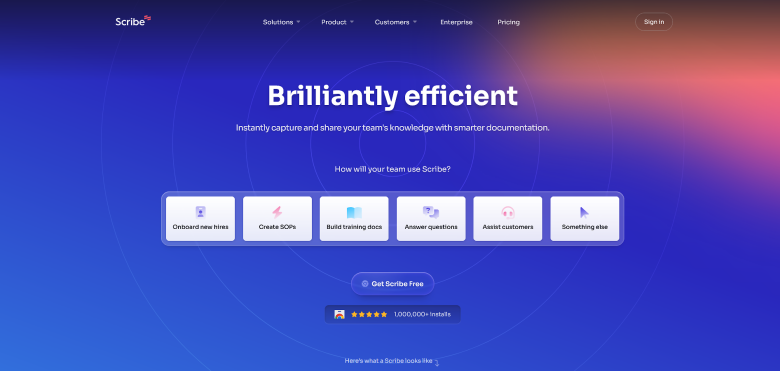 Website: scribehow.com
Website: scribehow.comService Type: Step-by-step process documentation
Platforms: Chrome extension, Edge extension, Desktop (for paid users)
Price: Free (Paid plans start at $12/month per user) Scribe is used to create visual step-by-step guides by recording screen activity. It’s built to document processes, create training materials, and simplify onboarding. When you complete a task in your browser, Scribe automatically generates a guide with text instructions and annotated screenshots. The free browser extension allows users to capture workflows from any web application. Guides can be edited, shared via link, or embedded into other platforms. Basic customization options are available, such as adding titles, tips, and descriptions. The free plan supports browser-based capture only and is intended for individual use. It lacks support for desktop and mobile recording, team collaboration, branding, and redaction tools. Features like Pages for guide organization, advanced formatting, and admin controls are only available on paid plans. Upgrading unlocks desktop capture, shared workspaces, custom theming, GIF support, viewer insights, and access to Scribe’s Sidekick tool, which helps users surface relevant guides as they work. Key features:
- Capture browser-based workflows
- Auto-generate step-by-step guides with text and annotated screenshots
- Share guides via public links or embed in other platforms
- Desktop capture and team workspaces (for paid users)
25. Todoist
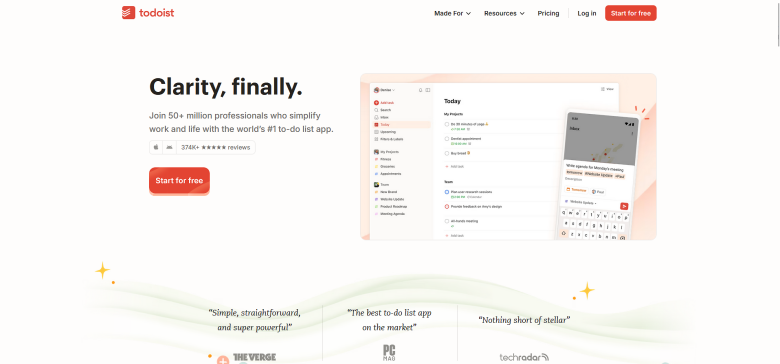 Website: todoist.com
Website: todoist.comService Type: Task management
Platforms: Web, Windows, Mac, Linux, iOS, Android, Apple Watch, WearOS, browser extensions, email extensions
Price: Free (Paid plans start at $4/month) Todoist is built to organize personal and team to-do lists. It’s best suited for lightweight task tracking, recurring tasks, and simple collaboration. It is not designed for complex project management, as it lacks features like time tracking, resource planning, and advanced team controls. Users can organize tasks into projects, assign due dates, apply labels or priorities, and switch between list, calendar, or board views. Tasks can be shared within projects, with support for comments and basic collaboration. The free plan includes up to five personal projects, five collaborators per project, three filters, and one week of activity history. Users can set recurring due dates, add task descriptions, and integrate with calendars, email, and other tools. Limitations include no access to reminders, sub-tasks, productivity reports, or custom roles. File uploads are capped at 5MB, and features like shared billing, admin controls, and advanced formatting require a paid plan. Key features:
- Organize tasks into up to 5 personal projects
- Share projects with up to 5 collaborators each
- Add reminders and sub-tasks to manage deadlines more precisely (for paid users)
26. Trello
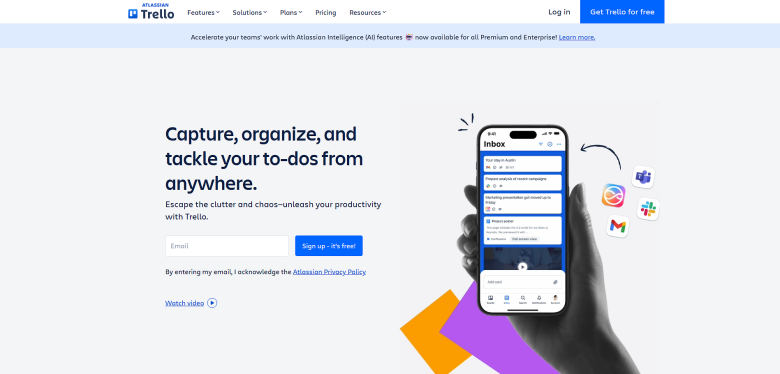 Website: trello.com
Website: trello.comService Type: Project and task management
Platforms: Windows, Mac, iOS, Android
Price: Free (Paid plans start at $5/month) Trello is a visual task management tool that helps teams plan, track, and organize their work. Projects are managed using boards (workspaces for a project), lists (stages or categories), and cards (individual tasks or items). Users can move cards between lists to reflect progress or updates. The free plan includes unlimited cards and up to 10 boards per workspace. It supports integrations with Slack, Microsoft Teams, and email, and includes an inbox to collect updates from those platforms. Users also get 250 automation runs per month through Trello’s Butler feature, access to mobile apps, and standard tools like due dates, assignees, and two-factor authentication. Power-Ups allow users to add extra features or connect third-party apps. The free plan includes unlimited (free) Power-Ups per board, with a 10MB file upload limit and no cap on overall storage. The free plan does not include features like calendar or timeline views, card mirroring, or custom fields, and some Power-Ups require a separate subscription fee.
Key Features:
- Unlimited cards and up to 10 boards per workspace
- Integrations with email, Slack, and Microsoft Teams
- Unlimited Power-Ups per board and 10MB file upload limit
- 250 monthly automation runs using Trello’s Butler tool
Website Building and Hosting
A professional website helps establish trust and gives your business a place to grow online. These tools offer free or affordable options for creating, customizing, and hosting your site, even if you don’t know how to code.27. Infinity Free
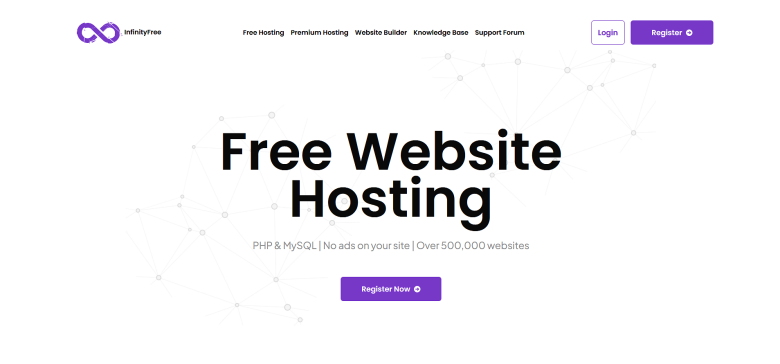 Website: infinityfree.com
Website: infinityfree.comService Type: Free web hosting
Platform: Web
Price: Free InfinityFree is a free web hosting platform offering unlimited bandwidth, support for unlimited websites, and no ads or time limits. It includes 5 GB of storage, PHP 8.3 support, MySQL databases, free SSL certificates, and access to over 400 one-click app installs, including WordPress. Users can build websites with a drag-and-drop editor and choose from 200+ responsive templates optimized for SEO. InfinityFree does not offer domain registration, but you can use your own domain registered elsewhere. The service is suitable for personal sites, small projects, and startups looking to keep costs low. No credit card is required to sign up. However, InfinityFree has some limitations. There is no direct customer support, so help is limited to a community forum and documentation. The platform may also fall short for high-traffic or resource-intensive websites, as performance and scalability are limited compared to paid hosting solutions. Key Features:
- Free web hosting with no ads
- 5 GB of disk space and unlimited bandwidth
- Access to 400+ one-click app installs, including WordPress
- Drag-and-drop site builder with 200+ SEO-optimized templates
28. Webador
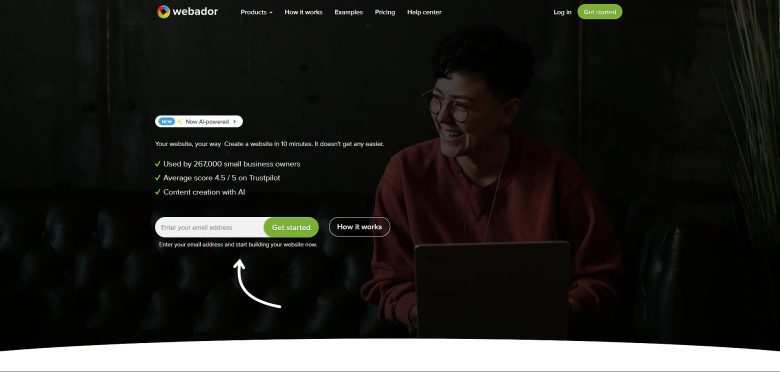 Website: webador.com
Website: webador.comService Type: Drag-and-drop website builder
Platform: Web
Price: Free (Paid plans start at $7/month) Webador is a beginner-friendly website builder designed for those who want to create a professional website without technical experience. Its intuitive drag-and-drop editor, responsive templates, and built-in SEO tools ease the process of launching a personal site, blog, or portfolio. The free plan includes hosting, SSL security, access to over 50 templates, and more than 100,000 free stock images. It also supports unlimited data traffic and allows you to create up to three pages using a Webador-branded subdomain. Webador’s AI-powered features help with content optimization and layout suggestions. While the free plan is suitable for simple personal or hobby sites, paid plans unlock additional capabilities like e-commerce, custom domains, email accounts, password protection, and analytics. Key Features:
- Drag-and-drop website builder with no coding required
- Free hosting with a Webador-branded subdomain
- 50+ responsive templates and access to 100,000+ stock images
- Built-in SEO tools and SSL-secured connection
- AI-powered layout and content optimization suggestions
29. Wix
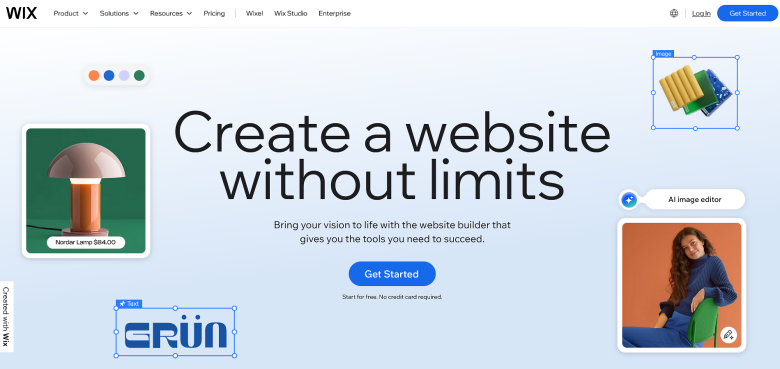 Website: wix.com
Website: wix.comService Type: Drag-and-drop website builder
Platforms: Web, iOS, Android
Price: Free (Paid plans start at $17/month) Wix is a user-friendly website builder designed for individuals and businesses looking to create a custom site without coding. It offers over 500 templates, a drag-and-drop editor, built-in SEO tools, and support for mobile optimization. Users can also build sites with Wix’s AI tool, which generates layouts based on a short questionnaire. The platform includes advanced design features like animations, scroll effects, and video backgrounds. For those with technical experience, custom code can be added for improved functionality. Wix also provides web hosting and SSL certificates at no extra cost. The free plan includes access to templates, basic design tools, and hosting, but limits users to 500MB of storage and bandwidth. Sites on the free plan display Wix-branded ads and use a Wix subdomain (e.g., yoursite.wixsite.com). Key features like Google Analytics, e-commerce tools, and custom domain support require a paid plan. Key Features:
- Drag-and-drop website editor with no coding required
- Access to over 500 customizable templates
- Mobile-optimized design tools included
- Built-in SEO tools for basic search visibility
- Free hosting and SSL security with a Wix subdomain
30. WordPress
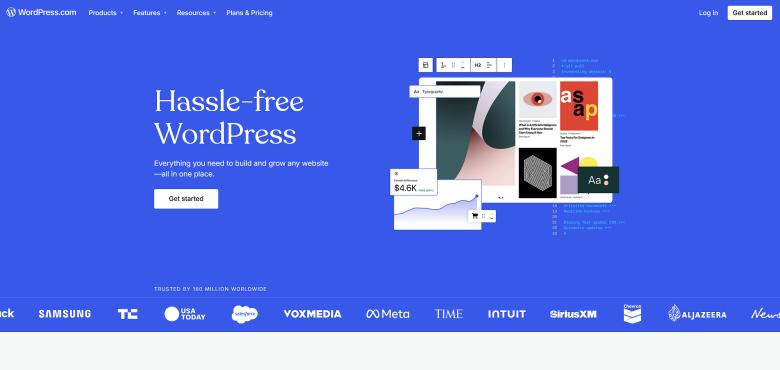 Website: wordpress.com
Website: wordpress.comService Type: Website builder and content management system
Platforms: Web, Windows, Mac, Linux, iOS, Android
Price: Free (Paid plans start at $4/month) WordPress is a free, open-source platform for building websites, used by over 800 million sites globally. It powers everything from personal blogs to large e-commerce stores, with support for extensive customization through themes and plugins. There are two main options: WordPress.com, which offers a free hosted website with limited features, and WordPress.org, a self-hosted version that requires separate web hosting but offers full control and flexibility. The free WordPress.com plan includes 3GB of storage, mobile-friendly themes, built-in SEO tools, and a WordPress.com subdomain. Users can customize themes, publish content, and access a large library of free plugins and templates. For online stores, the free WooCommerce plugin adds basic e-commerce functionality. However, the free tier has several restrictions. You can’t install third-party plugins, run your own ads, or remove WordPress.com branding. Monetization options and access to advanced features require a paid plan or switching to a self-hosted site via WordPress.org. Key Features:
- 3 GB of storage with a free WordPress.com subdomain
- Mobile-friendly, customizable themes
- Built-in SEO tools for search visibility
- Access to a wide range of free templates and plugins
The Bottom Line
Around 1 in 5 startups fail in their first year, and nearly 90% will eventually close down, according to Founders Factory Africa. The reasons vary, but many face challenges like inefficiency, disorganization, or taking on too much without the right support. The tools in this guide won’t guarantee success, but they can help you operate more effectively and avoid some of these common pitfalls. Canva helps you design professional visuals in minutes. Trello keeps your projects organized and moving forward. WordPress makes it possible to build and manage a website without needing a developer. MailerLite simplifies email marketing. HubSpot CRM helps you track leads and stay on top of your customer relationships. And Wave Accounting manages your finances. Most of these tools are free to use and easy to learn. Choosing the right ones early can help you save time, cut costs, and focus on scaling your business.Content attribution: Website Planet is the sole owner of the visual and written content on this website. You are free to share our content and visuals on your site, but we ask that you provide a link back to the resource if you do, enabling us to continue providing authoritative reviews and guides to help individuals and businesses thrive online.










